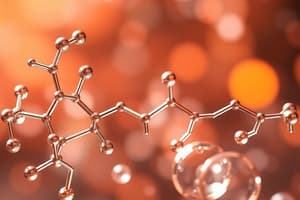Podcast
Questions and Answers
True or false:Az ismérvnek van ugyanaz a kémiai képlete, de eltérő a szerkezete?
True or false:Az ismérvnek van ugyanaz a kémiai képlete, de eltérő a szerkezete?
Mennyi ismert szerves vegyület van?
Mennyi ismert szerves vegyület van?
- Kb) 1 millió
- 4 millió ismert szerves vegyület van, amelyek többsége C, N, O, H-ból áll."
- Kb) 4 millió (correct)
- Csak néhány ezer
Milyen típusú vegyületek szerepelnek a legtöbbet az ismert szerves vegyületek között?
Milyen típusú vegyületek szerepelnek a legtöbbet az ismert szerves vegyületek között?
- Fémek vegyületei
- Szén, Nitrogén, Oxigén, Hidrogén vegyületei (correct)
- Üvegek vegyületei
- Szénhidrogének
Igaz vagy hamis: A szerves vegyületek főként C, N, O, H-ból állnak.
Igaz vagy hamis: A szerves vegyületek főként C, N, O, H-ból állnak.
Milyen típusú kötéseket tud kialakítani a szénatom?
Milyen típusú kötéseket tud kialakítani a szénatom?
Igaz vagy hamis: A szénatomok csak egy erős kovalens kötést tudnak képezni.
Igaz vagy hamis: A szénatomok csak egy erős kovalens kötést tudnak képezni.
Melyik állítás igaz a szénatomokról?
Melyik állítás igaz a szénatomokról?
Mi a funkcionális csoport?
Mi a funkcionális csoport?
Flashcards are hidden until you start studying
Study Notes
- There are approximately 4 million known organic compounds, mostly made up of C, N, O, H.
- The number of known inorganic compounds is in the hundreds of thousands.
- Carbon atoms can form four strong covalent bonds and can bond with other carbon atoms to create chains or rings.
- The arrangement of carbon atoms can vary, creating different structures called isomers.
- Isomers have the same chemical formula but different structures.
- Heteroatoms (O, N, P, S, halogens) can also be part of carbon compounds, altering their electron structure.
- Heteroatoms or groups of atoms attached to them are called functional groups.
- Examples of carbon compounds with heteroatoms are propanol and propylamine.
- The text provides examples of different isomers with the same molecular formula.
- The text explains the versatility of carbon atoms in forming complex and diverse molecules.
Studying That Suits You
Use AI to generate personalized quizzes and flashcards to suit your learning preferences.




